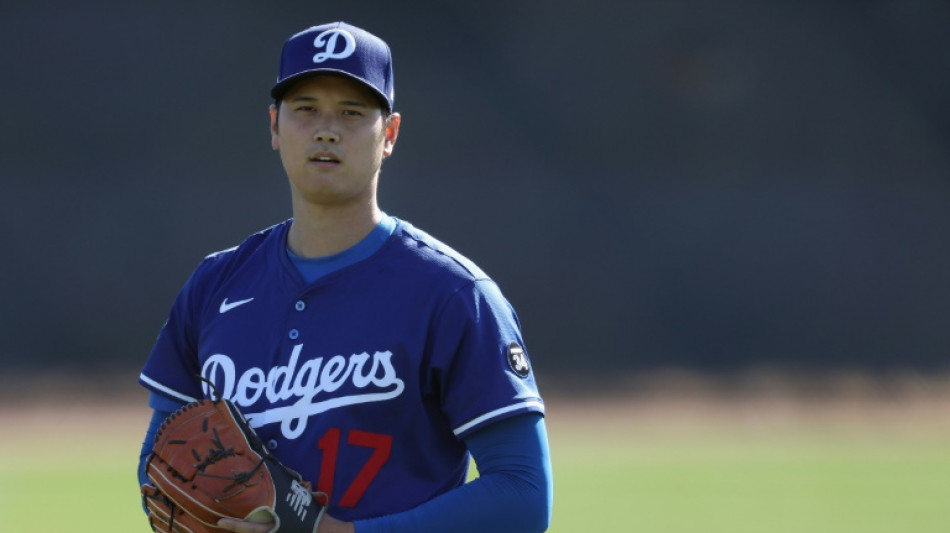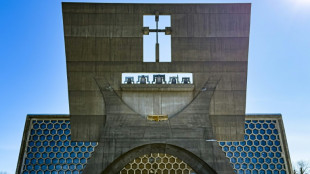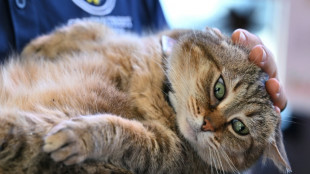
-
 Rubio defends Russia talks and criticism of Zelensky
Rubio defends Russia talks and criticism of Zelensky
-
Only one in six Japanese citizens has a passport, data shows

-
 Mongolians warm up on culture at new winter festival
Mongolians warm up on culture at new winter festival
-
Asian markets advance as Alibaba fuels Hong Kong tech rally

-
 Japan cabinet approves 'emergency' urban bear shootings
Japan cabinet approves 'emergency' urban bear shootings
-
Australia says China warned of 'live fire' drill off east coast

-
 Pakistan face India in Champions Trophy clash with no room for error
Pakistan face India in Champions Trophy clash with no room for error
-
Nepal community fights to save sacred forests from cable cars

-
 Trump tariffs leave WTO adrift in eye of the storm
Trump tariffs leave WTO adrift in eye of the storm
-
'Just two glasses': In Turkey, lives shattered by bootleg alcohol

-
 Nissan shares jump 11% on reported plan to seek Tesla investment
Nissan shares jump 11% on reported plan to seek Tesla investment
-
LeBron, Reaves dazzle as Lakers sink Blazers

-
 Cambodia to resume demining after US aid waiver
Cambodia to resume demining after US aid waiver
-
Canada enjoys emotional win as USA gets Olympic motivation

-
 Trump aid cut imperils water scheme in scorching Pakistan city
Trump aid cut imperils water scheme in scorching Pakistan city
-
Monaco battle to save season after Champions League exit

-
 Barcelona face Las Palmas with Liga lead strength test beckoning
Barcelona face Las Palmas with Liga lead strength test beckoning
-
Just 17% of Japan citizens hold passport, data shows

-
 Canada beats USA to win heated Four Nations Face-Off final
Canada beats USA to win heated Four Nations Face-Off final
-
Netanyahu orders 'intensive' West Bank operations after Israel bus blasts

-
 Macario back to scoring ways as USA beat Colombia
Macario back to scoring ways as USA beat Colombia
-
Australia's Cummins targets IPL for return from injury

-
 Most Asian markets rise as traders pick over week of headlines
Most Asian markets rise as traders pick over week of headlines
-
US sends migrants from Guantanamo to Venezuela

-
 Japan's core inflation rate hits 19-month high
Japan's core inflation rate hits 19-month high
-
Trump aid cut imperils water scheme in Pakistan's hottest city

-
 Big-gun Wallabies 'add energy' to Brumbies' Super Rugby campaign
Big-gun Wallabies 'add energy' to Brumbies' Super Rugby campaign
-
Bus blasts rock central Israel in 'suspected terror attack'

-
 Fishermen, sailing champions clean up trash-covered Rio island
Fishermen, sailing champions clean up trash-covered Rio island
-
What is Brutalism? And why do architects hate 'The Brutalist'?

-
 How a 'forgotten' Minnesota monastery inspired 'The Brutalist'
How a 'forgotten' Minnesota monastery inspired 'The Brutalist'
-
People can spread bird flu to their cats, US study suggests

-
 Blues coach braced for 'extremely competitive' Super Rugby season
Blues coach braced for 'extremely competitive' Super Rugby season
-
Liverpool face wounded Man City as Premier League title race heats up

-
 Wallabies skipper Wilson extends Reds deal till 2029
Wallabies skipper Wilson extends Reds deal till 2029
-
Dodgers pitcher checked for concussion after head-shot

-
 Musk vows to 'fix' X feature over Ukraine and Zelensky
Musk vows to 'fix' X feature over Ukraine and Zelensky
-
Japan's core inflation rate hits 3.2% in January

-
 Chainsaw-wielding Musk savors Trump's return to White House
Chainsaw-wielding Musk savors Trump's return to White House
-
Trump meets with Tiger, PIF and PGA Tour bosses to reunite golf

-
 Roma reach Europa League last 16 as 10-man Ajax scrape through
Roma reach Europa League last 16 as 10-man Ajax scrape through
-
MLS hoping for World Cup buzz in 30th season

-
 Bolivia's Morales launches 4th presidential bid, defying term limit
Bolivia's Morales launches 4th presidential bid, defying term limit
-
Harris Reed opens with 'rebellious' show at London Fashion Week opening

-
 Stocks mostly fall on tepid Walmart outlook, geopolitical worries
Stocks mostly fall on tepid Walmart outlook, geopolitical worries
-
Argentine court dismisses charges against 3 accused in death of singer Liam Payne

-
 Musk in X spat with Danish astronaut over 'abandoned' ISS crew
Musk in X spat with Danish astronaut over 'abandoned' ISS crew
-
Bond franchise shake-up moves spy into Amazon stable

-
 New York seeks hundreds of millions of dollars in 'vaping epidemic' case
New York seeks hundreds of millions of dollars in 'vaping epidemic' case
-
Dybala double leads Roma into Europa League last 16


MLB to launch pre-season testing of automated ball-strike calls
Major League Baseball will begin pre-season testing of an automated system to allow challenges of ball-strike calls on Thursday with the technology backstopping home plate umpires in about 60% of exhibition games.
The Automated Ball-Strike System (ABS) will receive its first test at Glendale, Arizona, between the Los Angeles Dodgers and Chicago Cubs.
Umpires have been declaring pitches in or out of the strike zone since the birth of the sport in the 1800s with plenty of disputes and argued calls since then.
But the ABS will be used in spring training games to help decide if such a system is ready to be used in future MLB regular-season contests, although it will not be used in the 2025 MLB campaign.
"This is a pretty big decision for the game of baseball that we want to get everybody to weigh in on," MLB executive vice president of baseball operations Morgan Sword said.
The ABS technology will be used in 13 pre-season ballparks shared by 19 teams so every club will have a chance to play with the ABS, which features a challenge system for ball and strike calls teams feel went the wrong way.
Home plate umpires will call balls and strikes on pitches as normal but the Hawk-Eye technology will monitor exact pitch locations relative to the strike zone for each batter.
Only a batter, pitcher or catcher can challenge an umpire call under the rules of the system, which allows each team to start with two challenges each.
Any challenge must be made immediately after an umpire's call without assistance from the team dugout or other players, with a player tapping his cap or helmet to indicate his desire to challenge.
The Hawk-Eye positioning review is shown on the video screen at stadiums and on television.
A team loses its challenge only if an umpire call is confirmed, so clubs can retain challenge rights for more than two challenges. No extra challenges are added should a game go beyond the regulation nine innings.
Testing in minor-league games averaged only an extra 17 seconds added to game times for each challenge. It also showed fans prefered the human element of umpiring remain in the game rather than a move to a fully automated system.
K.Thomson--BTB
